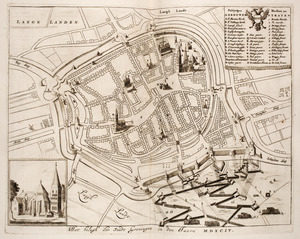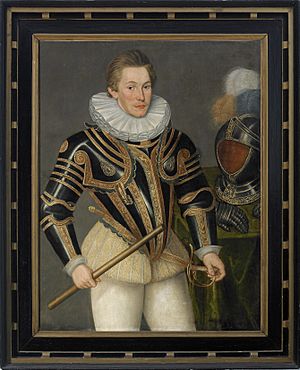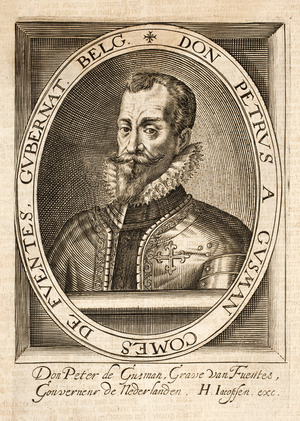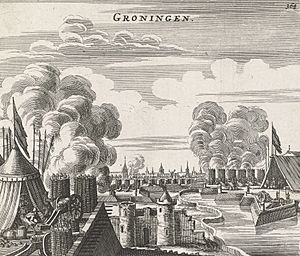Siege of Groningen (1594) facts for kids
Quick facts for kids Siege of Groningen |
|||||||
|---|---|---|---|---|---|---|---|
| Part of the Eighty Years' War and the Anglo-Spanish War | |||||||
 Print by Hugo Grotius |
|||||||
|
|||||||
| Belligerents | |||||||
| Commanders and leaders | |||||||
|
|
||||||
| Strength | |||||||
|
|
||||||
| Casualties and losses | |||||||
| 400 casualties | 400 casualties | ||||||
The Siege of Groningen was an important event during the Eighty Years' War and the Anglo-Spanish War. It was a two-month battle that started on May 19, 1594. During this time, the city of Groningen, which was controlled by Spain, was surrounded by a Dutch and English army.
This army was led by Prince Maurice of Orange. The Spanish forces in Groningen gave up on July 22, after a rescue attempt by the Count of Fuentes failed. This victory was very important for the Dutch Republic. It meant that the last Spanish soldiers were pushed out of the northern parts of the country. After the siege, Groningen joined the surrounding area. The city also changed from being mostly Catholic to Protestant. All Catholic property was taken away, and the Catholic religion was banned.
Contents
Why the Siege of Groningen Happened
At the end of the 1400s, Groningen was a very powerful city. It even controlled the nearby area of Friesland. When the Dutch started their fight against Spain, Groningen first joined the Dutch side. This was called the Union of Utrecht.
Groningen's Change of Sides
However, the leader of Groningen, George de Lalaing, Count of Rennenberg, changed his mind. He switched to the Spanish side in 1580. He sold the city to Spain for a lot of money. He also arrested important citizens and let the Spanish army into the city. This made Groningen a big problem for the Dutch Republic. Even though Friesland and other areas supported the Dutch uprising, Groningen's location made it hard for the Dutch to control the north.

Early Plans and Challenges
The Dutch Republic did not attack Groningen right away. The city had very strong defenses. Also, it was thought that the Spanish army inside was large enough to hold out. The Dutch government tried to make a deal with Groningen. They even offered to let Groningen be a free city. They also offered some religious freedom for Catholics.
But these talks failed. The military leaders, especially William Louis, did not trust Groningen. They worried it would betray them again, like Rennenberg had.
Preparing for the Siege
To get ready for the siege, William Louis slowly captured many small forts. These forts were called sconces. They were held by Spanish troops around Groningen. He started this in 1589. This helped weaken Spain's control over the city.
In 1591, Prince Maurice planned to attack Groningen. Almost half of his army was made up of English and Scottish soldiers. These troops were led by Sir Francis Vere. Queen Elizabeth I of England also sent more soldiers to help.
Capturing Key Locations
The Dutch and English forces first captured Delfzijl. This was an important port for Groningen. In the next year, Spanish soldiers were busy fighting in France. So, the Dutch and English went on the attack. They captured Steenwijk and Coevorden in 1592.
Maurice then sent William Louis to capture areas east of Groningen. This included the towns of Winschoten and Slochteren. This cut off Groningen from the German states. Maurice then captured Geertruidenberg in 1593.
William Louis also captured a key fort that cut off Groningen from its surrounding lands. The Spanish commander, Francisco Verdugo, tried to get it back. But it was too late in the year. Verdugo then tried to capture Coevorden. But Maurice came to help Coevorden in the spring of 1594. Verdugo gave up his attack and retreated. After this, the Dutch and English armies marched to Groningen. The Spanish army was having problems with soldiers leaving or refusing to fight. This made Groningen an easier target.
The Siege of Groningen Begins
On May 22, the Dutch and English forces arrived at Groningen. They started to surround the city. Their plan was to dig trenches and attack the south side. Groningen was a large town, but it only had about 400 German and Catholic soldiers. These were led by Mayor Alberto Jarges.
The city walls had many cannons. But as Maurice got closer, about 600 more Spanish and Flemish soldiers arrived. They were led by Jarichs Liauckema, a Spanish commander. This brought the city's defenders to almost 1,000. However, not everyone in Groningen was loyal to Spain. Many poor people were Catholic, but the rich citizens cared more about business. They thought joining the Dutch Republic would be better for the economy.
Attacking the City's Defenses
Maurice set up his main camp in the village of Haren. From there, they started attacking different parts of the city's defenses. They placed many siege cannons around the city. Some cannons attacked the Drenkelaar tower, others the Oosterpoort, and more attacked the Heerepoort.
Maurice also built small canals to move his cannons and supplies. Most of the small Spanish forts around the city were empty or easily captured. William Louis's troops had to fight to take the fort at Aduarderzijl. Once they captured it, the army could get supplies from Friesland. English soldiers, led by Vere, worked alongside Dutch soldiers in the trenches. The cannons started firing, and the city fired back. The Drenkelaar tower was partly destroyed, and the walls were damaged. But the city's defenders fought hard.
Challenges and Relief Attempts
A problem came up in late May. Queen Elizabeth of England wanted her English troops back. She needed them to fight in France. Sir Francis Vere, the English commander, asked the Dutch to replace his troops in other garrisons. This way, the siege could continue. The Dutch agreed, and the siege went on.
On June 3, more cannons were set up near the Oosterpoort. The English soldiers dug into the ground near the moat. They were exposed to enemy fire there. Heavy rain also made things difficult for the attackers. The Spanish defenders tried a surprise attack from the city. They attacked the Heerepoort, where the English were. Many English soldiers were killed or hurt before the Spanish were pushed back.

Many in the Dutch and English army thought the siege would be short. They believed the city wanted to join the Dutch Republic. But the leaders of Groningen refused to make a deal with Maurice. They were waiting for help from the Spanish Governor, Ernst of Austria. He ordered Pedro, Count of Fuentes, to rescue the city. He also told the defenders not to give up.
Fuentes tried to gather his army of less than 5,000 men. But his soldiers were refusing to fight, and Dutch cavalry kept attacking them. Eventually, with sickness, soldiers leaving, and injuries, the rescue attempt failed.
The Final Attack
By mid-June, the Oosterpoort became the main target for the cannons. Dutch and English engineers dug tunnels under the strong fort in front of the Oosterpoort. News of these tunnels spread in the city. Many people inside wanted to surrender.
Talks began between the city and the attackers. But fighting broke out among the citizens. Mayor Alberto Jarges and Liauckema ordered everyone to keep fighting. They warned that everyone would be executed if the Spanish army arrived and found them surrendering.
The tunneling continued at the Oosterpoort. On June 18, an English captain was killed. Francis Vere's younger brother, Horace Vere, took his place. Not long after, Maurice and Vere were looking at the walls. A cannonball hit their shield, throwing them to the ground. But they only had minor injuries.
On July 5, the tunnels were ready. Explosives were brought in and set off during the night. The huge explosions worked perfectly. After the dust cleared, the damaged forts were attacked. In fierce hand to hand combat, the attackers, including many Scottish soldiers, captured the position before morning. The attackers lost 150 men, but they killed 200 of the city's defenders.
Surrender of Groningen
Capturing this key position was too much for the city's defenders. There was no hope of rescue. Surrender was their only choice. A few days later, Liauckema and other important citizens met with Maurice. They agreed on the terms of surrender.
What Happened After the Siege
After the fighting stopped, Groningen got a good deal. The city and its citizens kept all their old rights. The Spanish soldiers were allowed to march out. The city would get new leaders chosen by William Louis. About 400 Spanish soldiers and 300 other defenders were killed or hurt. The city's request to keep at least one Catholic church was turned down.
In Groningen, the agreement was called the "Treaty of Reduction." The city officially joined the Dutch union as a province. However, religious rules changed a lot. All monks and priests had to leave. The city council was cleared of Catholics. From then on, Catholic worship was not allowed in the city.
Maurice, along with William Louis and Francis Vere, entered Groningen in triumph on July 15. Maurice then went to Amsterdam and then to The Hague. He was celebrated with great joy.
Impact of the Victory
For the Dutch Republic, capturing Groningen was a huge victory. The Spanish army had been almost completely pushed out of the northern provinces. This meant the seven Dutch provinces were now fully united. Verdugo, the Spanish commander, was called back by Archduke Ernest of Austria. His job was taken over by Herman van den Bergh.
The fall of Groningen also changed power in East Frisia, a German area. The Dutch government now placed soldiers in Emden. This forced the local leader to recognize the Dutch Republic in a treaty in 1595. Maurice and his army then rested. Later, they planned to take back cities in the northeast, like Enschede and Lingen. However, this campaign the next year was not successful.
A special medal was given to the new city council of Groningen. It was also given to members of the State Assembly and officers who helped capture the city. Groningen stayed united with the surrounding area. But it did not become a full province until 1795.
Images for kids



